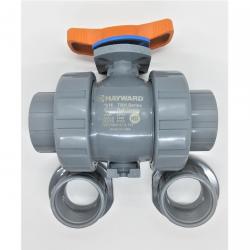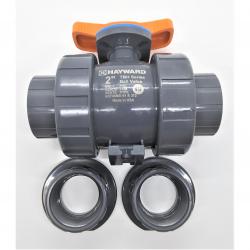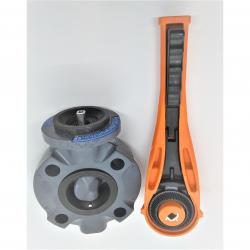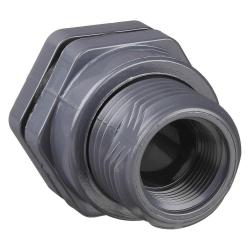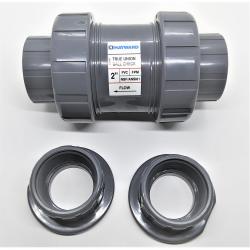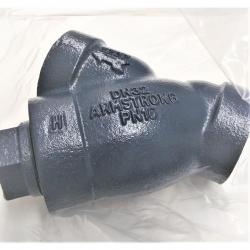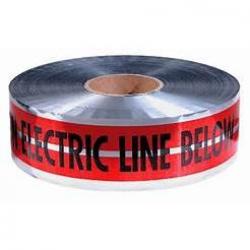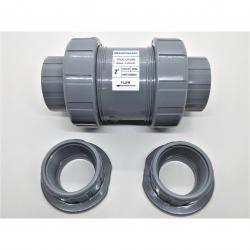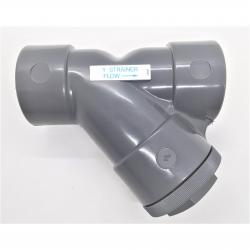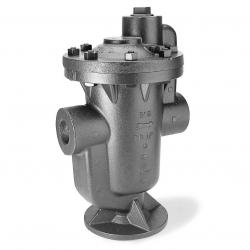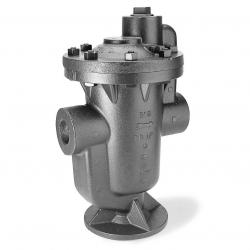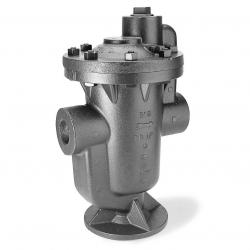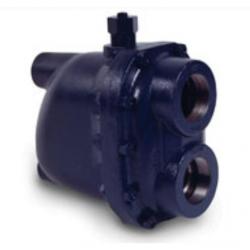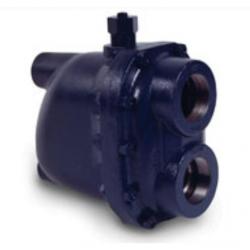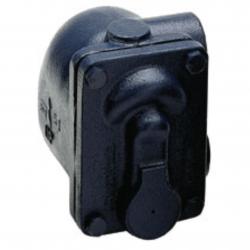Hayward
Armstrong International
View:
Active Filters :
- Brand: Armstrong International Hayward Imark/edn Milwaukee Electric
- Size: 1-1/4in 2in
Part #:700665
- The TBH Series features a low maintenance design with its new patent pending System2&trade Sealing Technology. Assisting users in protecting property and life, a standard integral lock-out feature secures onto the body of the valve. Actuator ready design with ISO 5211 pattern &ndash on all sizes. The System2&trade Sealing Technology utilizes the upstream seat as a backup to the downstream seat and enhances the sealing of the downstream seat. This insures longer life cycle and performance of the valve vs. conventional PTFE seats or seats with O-ring backing where uneven seat wear results in early failure mode. Available in sizes 1/4 through 2&rdquo / DN15 - DN50 in PVC and CPVC materials, the TBH Series are fully pressure rated for 250 PSI / PN16 at 70°F/23°C non-shock across all sizes and materials. Lastly, the TBH is available with IPS or DIN/EN socket, threaded and flanged end connections.
Full 250 psi / PN16 Rating, Non-Shock at 70°F / 23°C
Integral ISO 5211 Mounting Pad for Easy Actuation
Standard Lock-Out Plate, Lock-Out / Tag-Out for up to 4 Locks
System2&trade Sealing Technology Seat Carrier Design &ndash Patent Pending
Permanent Laser Markings, Eliminates Labels
System friendly ""Molded-In"" Footpad for Skid or Panel Mount
UV Resistant Sure Grip Ergonomic Handle
FPM or EPDM Seals
Double O-Ring Stem Seals
Reversible PTFE Seats - Standard
Easy Replacement for Existing Hayward TB Series
Qty:
Part #:700877
Qty:
Part #:701212
- The TBH Series features a low maintenance design with its new patent pending System2&trade Sealing Technology. Assisting users in protecting property and life, a standard integral lock-out feature secures onto the body of the valve. Actuator ready design with ISO 5211 pattern &ndash on all sizes. The System2&trade Sealing Technology utilizes the upstream seat as a backup to the downstream seat and enhances the sealing of the downstream seat. This insures longer life cycle and performance of the valve vs. conventional PTFE seats or seats with O-ring backing where uneven seat wear results in early failure mode. Available in sizes 1/4 through 2&rdquo / DN15 - DN50 in PVC and CPVC materials, the TBH Series are fully pressure rated for 250 PSI / PN16 at 70°F/23°C non-shock across all sizes and materials. Lastly, the TBH is available with IPS or DIN/EN socket, threaded and flanged end connections.
Full 250 psi / PN16 Rating, Non-Shock at 70°F / 23°C
Integral ISO 5211 Mounting Pad for Easy Actuation
Standard Lock-Out Plate, Lock-Out / Tag-Out for up to 4 Locks
System2&trade Sealing Technology Seat Carrier Design &ndash Patent Pending
Permanent Laser Markings, Eliminates Labels
System friendly ""Molded-In"" Footpad for Skid or Panel Mount
UV Resistant Sure Grip Ergonomic Handle
FPM or EPDM Seals
Double O-Ring Stem Seals
Reversible PTFE Seats - Standard
Easy Replacement for Existing Hayward TB Series
Qty:
Part #:702883
Qty:
Part #:703983
Qty:
Part #:703653
Qty:
Part #:713364
-
Y-Type Cast Iron Strainers
250 lb Screwed 1/2"-3" Class 125 Flanged 2"-6" Class 250 Flanged 2"-6"
Screen chambers won't leak or crush
Both ends of the chambers are precisely machined. This means perfectly round and smooth seating surfaces, as well as a fixed chamber length. Since the screen seats snugly on the machined surface, no particle bigger than the screen opening can escape around the end of the screen.
Screwed retainers easy in, easy out
Straight threads mean it takes less torque to achieve a tight seal with proper gasket compression. Less torque is also required to remove the retainer. For you, that means less danger of "freezing in" than with hard-to-break tapered pipe threads.
Off-center blowdown connections for better dirt removal
Off-center drains on 2-1/2" and 3" strainers allow you to remove liquid and dirt nearly completely when blowing down the strainer. Also, less liquid will spill when the screen retainer is removed.
Many screen choices
Many screen materials, meshes and perforations are available.
Qty:
Part #:713366
-
Y-Type Cast Iron Strainers
250 lb Screwed 1/2"-3" Class 125 Flanged 2"-6" Class 250 Flanged 2"-6"
Screen chambers won't leak or crush
Both ends of the chambers are precisely machined. This means perfectly round and smooth seating surfaces, as well as a fixed chamber length. Since the screen seats snugly on the machined surface, no particle bigger than the screen opening can escape around the end of the screen.
Screwed retainers easy in, easy out
Straight threads mean it takes less torque to achieve a tight seal with proper gasket compression. Less torque is also required to remove the retainer. For you, that means less danger of "freezing in" than with hard-to-break tapered pipe threads.
Off-center blowdown connections for better dirt removal
Off-center drains on 2-1/2" and 3" strainers allow you to remove liquid and dirt nearly completely when blowing down the strainer. Also, less liquid will spill when the screen retainer is removed.
Many screen choices
Many screen materials, meshes and perforations are available.
Qty:
closeout
$44.30 MSRP
$
29.85
Part #:204342
- CLOSEOUTS Only 3 Left!
- Feature Method (ASTM) Value (English)Overall Thickness D-2103 5.0 mil (Nominal)Foil Thickness D-2103 .35 milWeight D-2103 27.5 lbs / 1,000 ft2Tensile Strength D-882 Length 7,651 psi LengthElongation D-882 Length 89%Printability D-2578Plastic Density D-792-08
Qty:
Part #:700164
Qty:
Part #:700814
- The TBH Series features a low maintenance design with its new patent pending System2&trade Sealing Technology. Assisting users in protecting property and life, a standard integral lock-out feature secures onto the body of the valve. Actuator ready design with ISO 5211 pattern &ndash on all sizes. The System2&trade Sealing Technology utilizes the upstream seat as a backup to the downstream seat and enhances the sealing of the downstream seat. This insures longer life cycle and performance of the valve vs. conventional PTFE seats or seats with O-ring backing where uneven seat wear results in early failure mode. Available in sizes 1/4 through 2&rdquo / DN15 - DN50 in PVC and CPVC materials, the TBH Series are fully pressure rated for 250 PSI / PN16 at 70°F/23°C non-shock across all sizes and materials. Lastly, the TBH is available with IPS or DIN/EN socket, threaded and flanged end connections.
Full 250 psi / PN16 Rating, Non-Shock at 70°F / 23°C
Integral ISO 5211 Mounting Pad for Easy Actuation
Standard Lock-Out Plate, Lock-Out / Tag-Out for up to 4 Locks
System2&trade Sealing Technology Seat Carrier Design &ndash Patent Pending
Permanent Laser Markings, Eliminates Labels
System friendly ""Molded-In"" Footpad for Skid or Panel Mount
UV Resistant Sure Grip Ergonomic Handle
FPM or EPDM Seals
Double O-Ring Stem Seals
Reversible PTFE Seats - Standard
Easy Replacement for Existing Hayward TB Series
Qty:
Part #:702740
- new upc
Qty:
Part #:703637
Qty:
Part #:703651
Qty:
Part #:501-C5295-1
- Inverted Bucket Steam TrapsEnergy efficient because it's so reliable
The inverted bucket is the most reliable steam trap operating principle known. The heart of its simple design is a unique leverage system that multiplies the force provided by the bucket to open the valve against pressure.
Since the bucket is open at the bottom, it resists damage from water hammer, and wear points are heavily reinforced for long life. The inverted bucket has only two moving parts-the valve lever assembly and the bucket. That means no fixed points, no complicated linkage. Nothing to stick, bind or clog.
Conserves energy even in the presence of wear
Armstrong inverted bucket steam traps open and close based on the difference in density between condensate and steam-the inverted bucket principle. They open and close gently, minimizing wear. This simple fact means that inverted buckets are subject to less wear than some other types of traps.
In fact, as an Armstrong inverted bucket trap wears, its tight seal actually improves. The valve and seat of the Armstrong trap provide essentially line contact-resulting in a tight seal because the entire closing force is concentrated on one narrow seating ring.
An Armstrong inverted bucket steam trap continues to operate efficiently with use. Gradual wear slightly increases the diameter of the seat and alters the shape and diameter of the valve. But, as this occurs, a tight seal is still preserved-the ball merely seats itself more deeply.
Corrosion-resistant parts
The stainless steel valve and seat of the Armstrong inverted bucket steam trap are individually ground and lapped together in matched sets. All other working parts are wear- and corrosion-resistant stainless steel.
Venting of air and CO2
The Armstrong inverted bucket provides continuous automatic air and CO2 venting with no cooling lag or threat of air binding.
Operation against back pressure
The Armstrong inverted bucket has excellent performance against back pressure. It has no adverse effect on inverted bucket operation other than to reduce its capacity by the low differential. The bucket simply requires less force to pull the valve open and cycle the trap.
Freedom from dirt problems
Armstrong designed its inverted bucket to be virtually free of dirt problems. The valve and seat are at the top of the trap, far away from the larger particles of dirt, which fall to the bottom. Here, the up-and-down action of the bucket pulverizes them.
Since the valve of an inverted bucket is either fully closed or open, dirt particles pass freely. And the swift flow of condensate from under the bucket's edge creates a unique self-scrubbing action that sweeps dirt out of the trap.
Qty:
Part #:501-C5318-20
- Inverted Bucket Steam TrapsEnergy efficient because it's so reliable
The inverted bucket is the most reliable steam trap operating principle known. The heart of its simple design is a unique leverage system that multiplies the force provided by the bucket to open the valve against pressure.
Since the bucket is open at the bottom, it resists damage from water hammer, and wear points are heavily reinforced for long life. The inverted bucket has only two moving parts-the valve lever assembly and the bucket. That means no fixed points, no complicated linkage. Nothing to stick, bind or clog.
Conserves energy even in the presence of wear
Armstrong inverted bucket steam traps open and close based on the difference in density between condensate and steam-the inverted bucket principle. They open and close gently, minimizing wear. This simple fact means that inverted buckets are subject to less wear than some other types of traps.
In fact, as an Armstrong inverted bucket trap wears, its tight seal actually improves. The valve and seat of the Armstrong trap provide essentially line contact-resulting in a tight seal because the entire closing force is concentrated on one narrow seating ring.
An Armstrong inverted bucket steam trap continues to operate efficiently with use. Gradual wear slightly increases the diameter of the seat and alters the shape and diameter of the valve. But, as this occurs, a tight seal is still preserved-the ball merely seats itself more deeply.
Corrosion-resistant parts
The stainless steel valve and seat of the Armstrong inverted bucket steam trap are individually ground and lapped together in matched sets. All other working parts are wear- and corrosion-resistant stainless steel.
Venting of air and CO2
The Armstrong inverted bucket provides continuous automatic air and CO2 venting with no cooling lag or threat of air binding.
Operation against back pressure
The Armstrong inverted bucket has excellent performance against back pressure. It has no adverse effect on inverted bucket operation other than to reduce its capacity by the low differential. The bucket simply requires less force to pull the valve open and cycle the trap.
Freedom from dirt problems
Armstrong designed its inverted bucket to be virtually free of dirt problems. The valve and seat are at the top of the trap, far away from the larger particles of dirt, which fall to the bottom. Here, the up-and-down action of the bucket pulverizes them.
Since the valve of an inverted bucket is either fully closed or open, dirt particles pass freely. And the swift flow of condensate from under the bucket's edge creates a unique self-scrubbing action that sweeps dirt out of the trap.
Qty:
Part #:501-C5318-26
- Inverted Bucket Steam TrapsEnergy efficient because it's so reliable
The inverted bucket is the most reliable steam trap operating principle known. The heart of its simple design is a unique leverage system that multiplies the force provided by the bucket to open the valve against pressure.
Since the bucket is open at the bottom, it resists damage from water hammer, and wear points are heavily reinforced for long life. The inverted bucket has only two moving parts-the valve lever assembly and the bucket. That means no fixed points, no complicated linkage. Nothing to stick, bind or clog.
Conserves energy even in the presence of wear
Armstrong inverted bucket steam traps open and close based on the difference in density between condensate and steam-the inverted bucket principle. They open and close gently, minimizing wear. This simple fact means that inverted buckets are subject to less wear than some other types of traps.
In fact, as an Armstrong inverted bucket trap wears, its tight seal actually improves. The valve and seat of the Armstrong trap provide essentially line contact-resulting in a tight seal because the entire closing force is concentrated on one narrow seating ring.
An Armstrong inverted bucket steam trap continues to operate efficiently with use. Gradual wear slightly increases the diameter of the seat and alters the shape and diameter of the valve. But, as this occurs, a tight seal is still preserved-the ball merely seats itself more deeply.
Corrosion-resistant parts
The stainless steel valve and seat of the Armstrong inverted bucket steam trap are individually ground and lapped together in matched sets. All other working parts are wear- and corrosion-resistant stainless steel.
Venting of air and CO2
The Armstrong inverted bucket provides continuous automatic air and CO2 venting with no cooling lag or threat of air binding.
Operation against back pressure
The Armstrong inverted bucket has excellent performance against back pressure. It has no adverse effect on inverted bucket operation other than to reduce its capacity by the low differential. The bucket simply requires less force to pull the valve open and cycle the trap.
Freedom from dirt problems
Armstrong designed its inverted bucket to be virtually free of dirt problems. The valve and seat are at the top of the trap, far away from the larger particles of dirt, which fall to the bottom. Here, the up-and-down action of the bucket pulverizes them.
Since the valve of an inverted bucket is either fully closed or open, dirt particles pass freely. And the swift flow of condensate from under the bucket's edge creates a unique self-scrubbing action that sweeps dirt out of the trap.
Qty:
Part #:501-C5318-34
- Inverted Bucket Steam TrapsEnergy efficient because it's so reliable
The inverted bucket is the most reliable steam trap operating principle known. The heart of its simple design is a unique leverage system that multiplies the force provided by the bucket to open the valve against pressure.
Since the bucket is open at the bottom, it resists damage from water hammer, and wear points are heavily reinforced for long life. The inverted bucket has only two moving parts-the valve lever assembly and the bucket. That means no fixed points, no complicated linkage. Nothing to stick, bind or clog.
Conserves energy even in the presence of wear
Armstrong inverted bucket steam traps open and close based on the difference in density between condensate and steam-the inverted bucket principle. They open and close gently, minimizing wear. This simple fact means that inverted buckets are subject to less wear than some other types of traps.
In fact, as an Armstrong inverted bucket trap wears, its tight seal actually improves. The valve and seat of the Armstrong trap provide essentially line contact-resulting in a tight seal because the entire closing force is concentrated on one narrow seating ring.
An Armstrong inverted bucket steam trap continues to operate efficiently with use. Gradual wear slightly increases the diameter of the seat and alters the shape and diameter of the valve. But, as this occurs, a tight seal is still preserved-the ball merely seats itself more deeply.
Corrosion-resistant parts
The stainless steel valve and seat of the Armstrong inverted bucket steam trap are individually ground and lapped together in matched sets. All other working parts are wear- and corrosion-resistant stainless steel.
Venting of air and CO2
The Armstrong inverted bucket provides continuous automatic air and CO2 venting with no cooling lag or threat of air binding.
Operation against back pressure
The Armstrong inverted bucket has excellent performance against back pressure. It has no adverse effect on inverted bucket operation other than to reduce its capacity by the low differential. The bucket simply requires less force to pull the valve open and cycle the trap.
Freedom from dirt problems
Armstrong designed its inverted bucket to be virtually free of dirt problems. The valve and seat are at the top of the trap, far away from the larger particles of dirt, which fall to the bottom. Here, the up-and-down action of the bucket pulverizes them.
Since the valve of an inverted bucket is either fully closed or open, dirt particles pass freely. And the swift flow of condensate from under the bucket's edge creates a unique self-scrubbing action that sweeps dirt out of the trap.
Qty:
Part #:501-C5318-35
- Inverted Bucket Steam TrapsEnergy efficient because it's so reliable
The inverted bucket is the most reliable steam trap operating principle known. The heart of its simple design is a unique leverage system that multiplies the force provided by the bucket to open the valve against pressure.
Since the bucket is open at the bottom, it resists damage from water hammer, and wear points are heavily reinforced for long life. The inverted bucket has only two moving parts-the valve lever assembly and the bucket. That means no fixed points, no complicated linkage. Nothing to stick, bind or clog.
Conserves energy even in the presence of wear
Armstrong inverted bucket steam traps open and close based on the difference in density between condensate and steam-the inverted bucket principle. They open and close gently, minimizing wear. This simple fact means that inverted buckets are subject to less wear than some other types of traps.
In fact, as an Armstrong inverted bucket trap wears, its tight seal actually improves. The valve and seat of the Armstrong trap provide essentially line contact-resulting in a tight seal because the entire closing force is concentrated on one narrow seating ring.
An Armstrong inverted bucket steam trap continues to operate efficiently with use. Gradual wear slightly increases the diameter of the seat and alters the shape and diameter of the valve. But, as this occurs, a tight seal is still preserved-the ball merely seats itself more deeply.
Corrosion-resistant parts
The stainless steel valve and seat of the Armstrong inverted bucket steam trap are individually ground and lapped together in matched sets. All other working parts are wear- and corrosion-resistant stainless steel.
Venting of air and CO2
The Armstrong inverted bucket provides continuous automatic air and CO2 venting with no cooling lag or threat of air binding.
Operation against back pressure
The Armstrong inverted bucket has excellent performance against back pressure. It has no adverse effect on inverted bucket operation other than to reduce its capacity by the low differential. The bucket simply requires less force to pull the valve open and cycle the trap.
Freedom from dirt problems
Armstrong designed its inverted bucket to be virtually free of dirt problems. The valve and seat are at the top of the trap, far away from the larger particles of dirt, which fall to the bottom. Here, the up-and-down action of the bucket pulverizes them.
Since the valve of an inverted bucket is either fully closed or open, dirt particles pass freely. And the swift flow of condensate from under the bucket's edge creates a unique self-scrubbing action that sweeps dirt out of the trap.
Qty:
Part #:501-C5318-36
- Inverted Bucket Steam TrapsEnergy efficient because it's so reliable
The inverted bucket is the most reliable steam trap operating principle known. The heart of its simple design is a unique leverage system that multiplies the force provided by the bucket to open the valve against pressure.
Since the bucket is open at the bottom, it resists damage from water hammer, and wear points are heavily reinforced for long life. The inverted bucket has only two moving parts-the valve lever assembly and the bucket. That means no fixed points, no complicated linkage. Nothing to stick, bind or clog.
Conserves energy even in the presence of wear
Armstrong inverted bucket steam traps open and close based on the difference in density between condensate and steam-the inverted bucket principle. They open and close gently, minimizing wear. This simple fact means that inverted buckets are subject to less wear than some other types of traps.
In fact, as an Armstrong inverted bucket trap wears, its tight seal actually improves. The valve and seat of the Armstrong trap provide essentially line contact-resulting in a tight seal because the entire closing force is concentrated on one narrow seating ring.
An Armstrong inverted bucket steam trap continues to operate efficiently with use. Gradual wear slightly increases the diameter of the seat and alters the shape and diameter of the valve. But, as this occurs, a tight seal is still preserved-the ball merely seats itself more deeply.
Corrosion-resistant parts
The stainless steel valve and seat of the Armstrong inverted bucket steam trap are individually ground and lapped together in matched sets. All other working parts are wear- and corrosion-resistant stainless steel.
Venting of air and CO2
The Armstrong inverted bucket provides continuous automatic air and CO2 venting with no cooling lag or threat of air binding.
Operation against back pressure
The Armstrong inverted bucket has excellent performance against back pressure. It has no adverse effect on inverted bucket operation other than to reduce its capacity by the low differential. The bucket simply requires less force to pull the valve open and cycle the trap.
Freedom from dirt problems
Armstrong designed its inverted bucket to be virtually free of dirt problems. The valve and seat are at the top of the trap, far away from the larger particles of dirt, which fall to the bottom. Here, the up-and-down action of the bucket pulverizes them.
Since the valve of an inverted bucket is either fully closed or open, dirt particles pass freely. And the swift flow of condensate from under the bucket's edge creates a unique self-scrubbing action that sweeps dirt out of the trap.
Qty:
Part #:501-C6123
- Automatic Differential Condensate Controllers
Armstrong automatic differential condensate controllers (DC) are designed to function on applications where condensate must be lifted from a drain point or in gravity drainage applications where increased velocity will aid in condensate drainage.
Lifting condensate from the drain pointoften referred to as siphon drainagereduces the pressure of the condensate, causing a portion of it to flash into steam. Since ordinary steam traps are unable to distinguish flash steam from live steam, they close and impeded drainage.
Increased velocity with gravity drainage will aid in drawing the condensate and air to the DC. An internal steam bypass controlled by a manual metering valve causes this increased velocity. Therefore, the condensate controller automatically vents the bypass or secondary steam. This steam is then collected for use in other heat exchangers or discharged to the condensate return line.
Capacity considerations for draining equipment vary greatly, according to the application. However, a single condensate controller provides sufficient capacity for most applications..
How they work
Condensate, air and steam (live and flash) enter through the controller inlet. At this point, flash steam and air are automatically separated from the condensate. Then they divert into the integral bypass at a controlled rate, forming secondary steam.
The valve is adjustable so it matches the amount of flash present under full capacity operation or to meet the velocity requirements of the system. The condensate discharges through a separate orifice by the inverted bucket.
Because of the dual-orifice design, there is a preset controlled pressure differential for the secondary steam system, while maximum pressure differential is available to discharge the condensate.
Qty:
Part #:501-C6124
- Float and Thermostatic (F&T) Steam TrapsThe More Your Steam Pressure Varies, The More You Need Armstrong F&T TrapsWhen steam pressure may vary from maximum steam supply pressure to vacuum, Armstrong F&Ts are your most energy-efficient choice. Our line of F&Ts brings Armstrong performance, dependability and long life to trapping services requiring continuous drainage with high air venting capacity. Thanks to separate orifices for condensate and air, they provide continuous condensate drainage and air venting-even under conditions of zero pressure.
All the benefits detailed here have been designed into Armstrong F&Ts through long experience in the manufacture of pressure float-type traps. They assure you of optimum operating efficiency for long periods with minimum trouble.
How they work
Float and thermostatic traps are mechanical units that operate on both density and temperature principles. The float valve operates on the density principle. A level connects the ball float to the valve and seat. Once condensate reaches a certain level in the trap, the float rises, opening the orifice and draining condensate. A water seal formed by the condensate prevents live steam loss.
Since the discharge valve is under water, it is not capable of venting air and non-condensables. When the accumulation of air and con-condensable gases causes a significant temperature drop, a thermostatic air vent in the top of the trap discharges them. The thermostatic vent opens at a temperature a few degrees below saturation, so it's able to handle a large volume of air-through an entirely separate orifice-but at a slightly reduced temperature.
Built as tough as the jobs they do
Armstrong float and thermostatic traps are unique in their super heavy duty construction. Armstrong uses high quality ASTM A48 Class 30 cast iron or ASTM A216 WCB cast steel-normally found in pressure vessels rated to 250 psi (17 bar) or 465 psi (32 bar). Internal mechanisms are made from stainless steel and are heavily reinforced. No brass cotter pins here. Valves and seats are stainless steel, hardened, ground and lapped to withstand the erosive forces of flashing condensate.
Why go to all this trouble for traps normally recommended for low-pressure, modulating service? The operative word here is modulating. Modulating pressures mean widely varying loads, thermal cycling and high air and non-condensable gas loads.
In other words tough service. Inferior, lightweight construction in this kind of service is a mistake waiting to happen. Trap failures on modulating pressure may lead to water hammer, corrosion and even damage to heat exchangers.
Armstrong's published capacities are based on actual measurements of traps handling hot, flashing condensate. Competitive F&Ts may utilize theoretical calculated capacities. Armstrong uses its own steam lab to give you actual capacity-especially important on high-capacity traps such as those in our ultra-capacity line. Not only does Armstrong offer super heavy duty construction for long life and reliability, but we also supply the data to back up performance. Here's a simple, easy-to-remember summary The more your pressure varies, the more you need Armstrong F&Ts.
Qty:
Part #:501-C6125
- Automatic Differential Condensate Controllers
Armstrong automatic differential condensate controllers (DC) are designed to function on applications where condensate must be lifted from a drain point or in gravity drainage applications where increased velocity will aid in condensate drainage.
Lifting condensate from the drain pointoften referred to as siphon drainagereduces the pressure of the condensate, causing a portion of it to flash into steam. Since ordinary steam traps are unable to distinguish flash steam from live steam, they close and impeded drainage.
Increased velocity with gravity drainage will aid in drawing the condensate and air to the DC. An internal steam bypass controlled by a manual metering valve causes this increased velocity. Therefore, the condensate controller automatically vents the bypass or secondary steam. This steam is then collected for use in other heat exchangers or discharged to the condensate return line.
Capacity considerations for draining equipment vary greatly, according to the application. However, a single condensate controller provides sufficient capacity for most applications..
How they work
Condensate, air and steam (live and flash) enter through the controller inlet. At this point, flash steam and air are automatically separated from the condensate. Then they divert into the integral bypass at a controlled rate, forming secondary steam.
The valve is adjustable so it matches the amount of flash present under full capacity operation or to meet the velocity requirements of the system. The condensate discharges through a separate orifice by the inverted bucket.
Because of the dual-orifice design, there is a preset controlled pressure differential for the secondary steam system, while maximum pressure differential is available to discharge the condensate.
Qty:
Part #:501-D1175-10
- Float and Thermostatic (F&T) Steam TrapsThe More Your Steam Pressure Varies, The More You Need Armstrong F&T TrapsWhen steam pressure may vary from maximum steam supply pressure to vacuum, Armstrong F&Ts are your most energy-efficient choice. Our line of F&Ts brings Armstrong performance, dependability and long life to trapping services requiring continuous drainage with high air venting capacity. Thanks to separate orifices for condensate and air, they provide continuous condensate drainage and air venting-even under conditions of zero pressure.
All the benefits detailed here have been designed into Armstrong F&Ts through long experience in the manufacture of pressure float-type traps. They assure you of optimum operating efficiency for long periods with minimum trouble.
How they work
Float and thermostatic traps are mechanical units that operate on both density and temperature principles. The float valve operates on the density principle. A level connects the ball float to the valve and seat. Once condensate reaches a certain level in the trap, the float rises, opening the orifice and draining condensate. A water seal formed by the condensate prevents live steam loss.
Since the discharge valve is under water, it is not capable of venting air and non-condensables. When the accumulation of air and con-condensable gases causes a significant temperature drop, a thermostatic air vent in the top of the trap discharges them. The thermostatic vent opens at a temperature a few degrees below saturation, so it's able to handle a large volume of air-through an entirely separate orifice-but at a slightly reduced temperature.
Built as tough as the jobs they do
Armstrong float and thermostatic traps are unique in their super heavy duty construction. Armstrong uses high quality ASTM A48 Class 30 cast iron or ASTM A216 WCB cast steel-normally found in pressure vessels rated to 250 psi (17 bar) or 465 psi (32 bar). Internal mechanisms are made from stainless steel and are heavily reinforced. No brass cotter pins here. Valves and seats are stainless steel, hardened, ground and lapped to withstand the erosive forces of flashing condensate.
Why go to all this trouble for traps normally recommended for low-pressure, modulating service? The operative word here is modulating. Modulating pressures mean widely varying loads, thermal cycling and high air and non-condensable gas loads.
In other words tough service. Inferior, lightweight construction in this kind of service is a mistake waiting to happen. Trap failures on modulating pressure may lead to water hammer, corrosion and even damage to heat exchangers.
Armstrong's published capacities are based on actual measurements of traps handling hot, flashing condensate. Competitive F&Ts may utilize theoretical calculated capacities. Armstrong uses its own steam lab to give you actual capacity-especially important on high-capacity traps such as those in our ultra-capacity line. Not only does Armstrong offer super heavy duty construction for long life and reliability, but we also supply the data to back up performance. Here's a simple, easy-to-remember summary The more your pressure varies, the more you need Armstrong F&Ts.
Qty:
Displaying: 1 - 24 of 347 Matching Items


